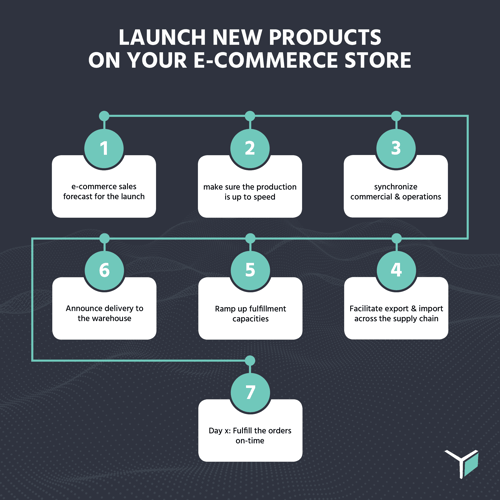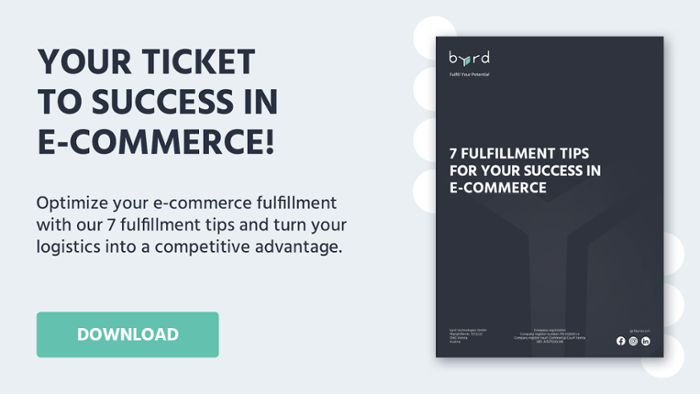How to successfully launch new products on e-commerce stores
Table of Content
Expanding the product range is a great possibility to engage existing customers and win new ones by facilitating attention-grabbing marketing campaigns that announce the new arrivals. E-commerce businesses invest a lot of their time and resources into the development of new products and marketing teams spend countless hours on building campaigns to foster the awareness for the launch that it deserves. However, too many times webshops fail with their product launch because they do not coordinate their activities with the operations team, which leads to bottlenecks in the supply chain and e-commerce fulfillment process. In this blog we will explain which factors e-commerce shops have to consider when launching new products so that the initial sale is a complete success:
Too many times webshops fail with their product launch because they do not coordinate their activities with the operations team, which leads to bottlenecks in the supply chain and e-commerce fulfillment process.
Marketing & sales forecast for e-commerce sales
As a first step, it is important to get feedback from the Commercial team about the sales targets and forecast for the product launch. In most cases, this needs to happen well in advance in order to be in a position to have the complex supply chain processes aligned properly. The number of expected orders is then to be communicated with the Operations department.
Making sure that the production is up to speed
Based on the forecast, the Operations department gets in touch with the producer or wholesaler to communicate the plans accordingly, including a launch timeline. This will give the producer the possibility to reserve capacities and to give feedback in case of potential bottlenecks. If this is the case, the Operations team should ask about backup plans or search for other producers that could help out in case such problems occur.
Synchronizing Commercial and Operations
After having cleared up all remaining questions regarding the production capacities, the Commercial team needs to be informed and updated. If necessary, bottlenecks in the supply chain should be considered in the marketing plan, which may lead to a postponement of the product launch and as a consequence for the e-commerce marketing activities. This shows that syncing marketing and operations in-time is essential in order to avoid burning money with early marketing activities.
In fact, desynchronized commercial and operational planning can lead to serious issues for the launch of products. In many cases, this leads to online shoppers having to wait for a long time for the ordered products, which translates into unsatisfied customers. Even if the initial e-commerce sales stats might look promising, it will most likely lead to a decrease in the Customer-Lifetime-Value (LTV).
Optimize your Import/Export activities
Supply Chains are complex and often require goods and raw materials to be shipped across borders. Although many e-commerce businesses are dealing with cross-border trade and international shipments on a regular basis, they still fail at taking action to facilitate a smooth and hassle-free Import/Export. In order to avoid delays at the border and having orders being stuck in the customs, it is crucial to fill out all customs declarations accordingly and talk to experts that can provide consultancy.
Ramping up e-commerce fulfillment capacities
Depending on the e-commerce fulfillment-strategy the businesses need to take action to get their fulfillment capacities up to snuff:
In-house logistics: in this case, it is mostly about ensuring that picking and packing processes are mapped out in detail, are efficient, and are easily understandable. This is a prerequisite for an efficient order fulfillment process as warehouse workers won’t need extensive training to learn the process for the new products.
Outsourced fulfillment: here it is important to announce the expected order peaks to the fulfillment provider so that the capacities can be ramped up according to the forecast, ensuring that orders are fulfilled in-time.
In any case, it will also be necessary to coordinate other materials that might be needed for the fulfillment of the orders, which have to be ordered well in advance as well. This can be customized packaging or branding material (like flyers). Those little extras can improve the unboxing experience for consumers and as a consequence have a tremendous effect on brand awareness on social channels.
Announcing the delivery to the fulfillment warehouse
E-commerce businesses need to make sure to announce the delivery a few days in advance so that the warehouse can prepare by freeing up space at the right spaces to ensure an efficient picking process and tour planning of the warehouse workers.
Also, it is recommended to use barcodes, delivery notes, and identifiers of the respective delivery to enable smooth and rapid inbounding of the delivery. This will ensure that the critical orders, with new products, can be fulfilled on-time.
Fulfilling order peaks on-time
The day has come: the product is officially launched and e-commerce businesses might have registered some presales already. Especially, when collaborating with influencers or releasing press announcements, e-commerce stores might face a lot of traffic at once. In such cases, it is crucial to have a stable tech-infrastructure that will ensure that the order data is transmitted to the warehouse. In the past, we have seen that Shopify fulfills those requirements quite well, because they have a scalable infrastructure, as compared to some other shop systems.
From a fulfillment perspective, the logistics managers need to plan shifts accordingly and allocate orders to the right warehouse workers. This can make the picking and packing process more efficient so that more orders can be fulfilled and shipped on the same day. As a consequence, online shoppers will receive their ordered items in no time, which will lead to customer satisfaction.
Concluding remarks
To summarize, communication is key when it comes to launching new products and webshops need to take into consideration several factors when launching new products. Successful launch of a product encompasses much more than just marketing and selling online and a lack of communication and planning can quickly lead to huge order backlogs, increased stress levels in the warehouse, wrongly packaged goods, and delivery delays. This, in turn, leads to unsatisfied customers and loss of business. Ensuring that orders are successfully delivered in-time to consumers requires a lot of planning and coordination. Taking into account the guidelines shared in this blog will facilitate successful product launches which can contribute to the long-term success of your business and future product launches.

